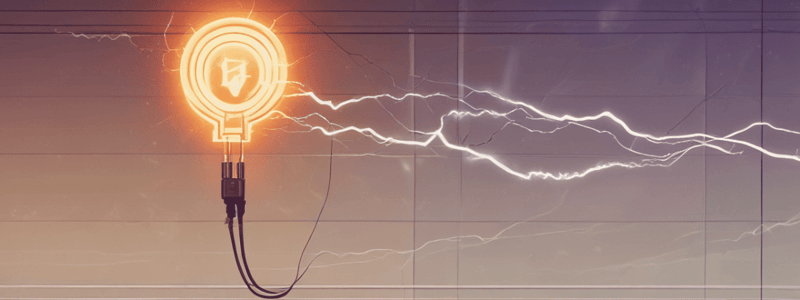Podcast
Questions and Answers
Что такое сопротивление (R) в электрической цепи?
Что такое сопротивление (R) в электрической цепи?
- Параметр, определяющий количество электронов, проходящих через материал за единицу времени
- Свойство материалов, которое определяет, насколько они препятствуют протеканию электрического тока (correct)
- Мера силы электрического поля, действующего на заряженные частицы в цепи
- Способность цепи передавать энергию от одной точки к другой
Как измеряется сопротивление (R) в электрической цепи?
Как измеряется сопротивление (R) в электрической цепи?
- В Вольтах (В)
- В Кулонах (Кл)
- В амперах (А)
- В Омах (Ω) (correct)
Что представляет собой напряжение (V) в электрической цепи?
Что представляет собой напряжение (V) в электрической цепи?
- Степень противодействия материала протеканию электрического тока
- Меру силы электрического поля, действующего на заряженные частицы
- Способность цепи передавать энергию от одной точки к другой (correct)
- Количество электронов, проходящих через материал за единицу времени
Какое уравнение описывает закон Ома, связывающий напряжение (V), ток (I) и сопротивление (R)?
Какое уравнение описывает закон Ома, связывающий напряжение (V), ток (I) и сопротивление (R)?
Как изменится ток (I) в цепи, если увеличить напряжение (V) при постоянном сопротивлении (R)?
Как изменится ток (I) в цепи, если увеличить напряжение (V) при постоянном сопротивлении (R)?
Как изменится ток (I) в цепи, если увеличить сопротивление (R) при постоянном напряжении (V)?
Как изменится ток (I) в цепи, если увеличить сопротивление (R) при постоянном напряжении (V)?
Что представляет собой формула Ома?
Что представляет собой формула Ома?
Каково отношение силы тока к напряжению в соответствии с законом Ома?
Каково отношение силы тока к напряжению в соответствии с законом Ома?
Что произойдет с силой тока через проводник, если его сопротивление увеличится?
Что произойдет с силой тока через проводник, если его сопротивление увеличится?
Как изменится ток в цепи, если удвоить напряжение при постоянном сопротивлении?
Как изменится ток в цепи, если удвоить напряжение при постоянном сопротивлении?
Как ведет себя сила тока при увеличении сопротивления проводника?
Как ведет себя сила тока при увеличении сопротивления проводника?
Как закон Ома помогает в проектировании электрических цепей?
Как закон Ома помогает в проектировании электрических цепей?
Flashcards are hidden until you start studying
Study Notes
Electric Current and Ohm's Law: Understanding Resistance, Voltage, and Ohm's Law Formula
Introduction
Electric current plays a crucial role in various applications, including power generation, communication systems, and electronic devices. To understand and predict the behavior of electric current, scientists and engineers have established numerous principles and models. Among these is Ohm's Law, a fundamental law in the field of electrical engineering that defines the relationship among voltage, current, and resistance. In this article, we will explore the concepts of resistance, voltage, and the Ohm's Law formula.
Resistance (R)
Resistance, denoted as 'R', is a property of materials that determines how much they oppose the flow of electric current when an electric potential difference (voltage drop) is applied across them. The more resistant the material is, the fewer current carriers (such as electrons or ions) can pass through it. Resistance is typically measured in ohms (Ω) and depends on several factors, including the material properties, temperature, and geometry.
Voltage (V)
Voltage, commonly represented by the symbol 'V', measures the electric potential difference between two points in a circuit. It represents the ability of a circuit element to perform work against the opposition of the surrounding environment. The higher the voltage across an element, the faster it will transfer charges from one point to another, effectively driving a larger electric current.
Ohm's Law Formula
Ohm's Law, named after the German scientist Georg Simon Ohm, provides a straightforward approach to relate the voltage, current, and resistance in an electrical circuit. The formula is derived from the equation V = I × R, where V stands for voltage, I represents the current, and R signifies the resistance.
This law implies that the current (I) flowing through a conductor is directly proportional to the voltage (V) applied to it, assuming that all physical conditions and temperatures remain constant. Additionally, the resistance (R) of the conductor is inversely proportional to the current flowing through it; namely, when the resistance increases, the current decreases.
For example, if we double the voltage from point A to point B of a circuit while keeping the resistance constant, the current will also double. Similarly, if we quadruple the resistance, the current will decrease to a quarter of the original value. Moreover, this relationship holds true for any linear combination of voltage and resistance changes, ensuring that electrical circuits behave consistently under similar conditions.
Applications of Ohm's Law
Ohm's Law has extensive implications in designing and optimizing electrical circuits. It allows us to determine the maximum power that can be dissipated by a circuit element without exceeding the safe operating limits. Furthermore, this law simplifies the calculation of required values of voltage, current, or resistance for circuits containing ideal components, enabling accurate design predictions and troubleshooting.
Conclusion
Understanding the concepts of resistance, voltage, and the Ohm's Law formula is essential for anyone working in the field of electrical engineering. By applying these principles, we can design efficient, reliable, and cost-effective electrical systems.
Studying That Suits You
Use AI to generate personalized quizzes and flashcards to suit your learning preferences.




